Elephant is the largest animal that lives on land. Among all animals, only some kinds of whales are larger. The elephant is also the second tallest member of the animal kingdom. Only the giraffe is taller. Elephants are the only animals that have a nose in the form of a long trunk, which they use as a hand. They have larger ears than any other animal, and their tusks are the largest teeth.
Loading the player...Elephants
There are two kinds of elephants, African elephants and Asian elephants, also known as Indian elephants. However, many researchers today divide elephants into three species, two species of African elephant and one species of Asian elephant. The two species of African elephant are the bush elephant, also called the savanna elephant, and the forest elephant. They live only in Africa south of the Sahara. Asian elephants live in parts of India and Southeast Asia.
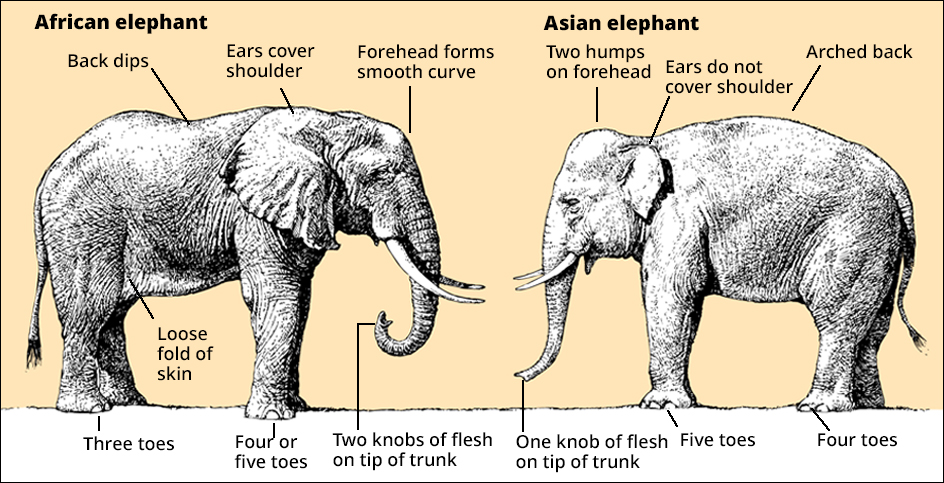
Elephants are extremely strong and highly intelligent. People have tamed and trained them for thousands of years. The logging industry in some Asian countries uses elephants to carry heavy loads. People throughout the world used to enjoy watching elephants perform tricks in circuses. However, scientists who have studied elephants in the wild have concluded that keeping such intelligent, social animals in captivity and training them in this way is cruel. The public’s attitude regarding such use of elephants has thus changed considerably. Today, many places ban the use of elephants in any traveling animal acts, and elephant sanctuaries, where many former circus elephants now live, take special care to provide for these elephants’ needs.
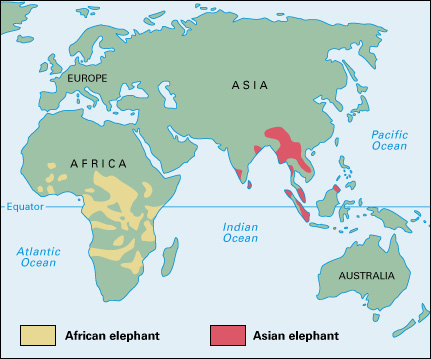
One of the earliest recorded uses of elephants took place in war. In 331 B.C., a Macedonian army led by Alexander the Great defeated Persian soldiers who rode elephants in battle. In 218 B.C., the famous general Hannibal of Carthage used elephants when he crossed the Alps and invaded Italy.

During the 1800’s, an African elephant named Jumbo was featured by the London Zoo for more than 17 years. Visitors came from all parts of the world to see Jumbo, the largest animal in captivity at that time. He stood 11 feet (3.4 meters) tall and weighed more than 14,500 pounds (6,550 kilograms). In 1882, the American showman P. T. Barnum purchased Jumbo and made the elephant a star attraction of his circus. The word jumbo became a common adjective for anything extremely large.
It is possible to travel to Africa and parts of Asia to see wild elephants in their own environment. However, the number of wild elephants has greatly declined because people kill elephants for their ivory tusks. In addition, people have settled on much of the land where the animals lived, resulting in a loss of habitat for the elephants. Farming and industry threaten the natural resources needed by elephants to survive. There is some uncertainty about the number of elephants that survive in the wild. In Asia, human population growth and habitat destruction have severely reduced the number of wild elephants. Scientists estimate that only about 40,000 Asian elephants survive in the wild. In Africa, the main cause of the decline in elephants is illegal hunting. In 1979, an estimated 1,300,000 elephants lived in Africa. Today, there are around 400,000.
A public awareness campaign was launched in the late 1980’s to save the African elephant. People throughout the world were made aware that thousands of elephants were being slaughtered every year to provide ivory jewelry and carvings. Japan was the greatest consumer of ivory. The Japanese used half the ivory that they imported for signature seals, traditional carved stamps used to print their names in ink. It was estimated that 12,000 elephants were killed each year to obtain ivory for these seals.
After a total ban on international ivory trade was imposed in 1990, some elephant populations in Africa began to recover. In 2008, a limited sale of ivory to China was allowed. It resulted in illegal trade once more, and thousands of elephants were killed. Under extreme pressure, China eventually banned the importation of ivory and domestic sales of ivory. However, other southeast Asian countries have continued the illegal trade of such items.
The importance of elephants
Wild elephants perform several important natural functions. For example, they help turn densely wooded areas into more open areas by feeding on trees and other plants. More kinds of animals can live in these open habitats. Elephants also dig holes in dry riverbeds to reach the water beneath the surface of the ground. Other animals then drink this water. When elephants travel through wooded areas, they create paths used by such animals as antelope and zebras.
Kinds of elephants
African elephants
are larger than Asian elephants. Wild African elephants live only in Africa south of the Sahara.
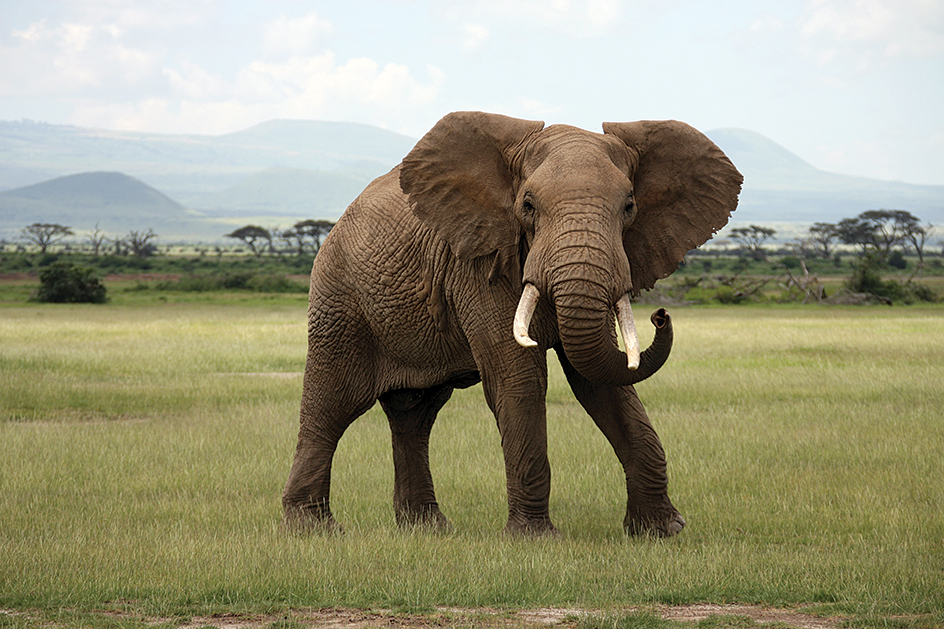
An African elephant is about the same height at the shoulder and the rump. Its back dips slightly in the middle. Adult African bull (male) elephants stand about 11 feet (3.4 meters) tall at the shoulder and weigh about 12,000 pounds (5,400 kilograms). The cows (females) are about 9 feet (2.7 meters) tall and weigh about 8,000 pounds (3,600 kilograms). The largest known elephant, an African bull, measured 13 feet 2 inches (4.01 meters) tall. The heaviest elephant ever weighed was more than 14,500 pounds (6,550 kilograms).

Most African elephants have dark gray skin. Their forehead forms a smooth curve. Their ears measure as wide as 4 feet (1.2 meters) and cover their shoulders. Both the bulls and cows have tusks. The tusks of most African bulls grow from 6 to 8 feet (1.8 to 2.4 meters) long and weigh 50 to 100 pounds (23 to 45 kilograms) each. The tusks of most of the cows weigh from 15 to 20 pounds (7 to 9 kilograms) each. The longest tusk of an African elephant measured 111/2 feet (3.5 meters), and the heaviest weighed 293 pounds (133 kilograms).
The trunk of an African elephant has two fleshy, fingerlike structures on the tip. The skin of the trunk has deep wrinkles. African elephants have four or five toes on each forefoot and three toes on each hind foot. A loose fold of skin joins the hind legs and the sides of the body. Asian elephants do not have this fold.
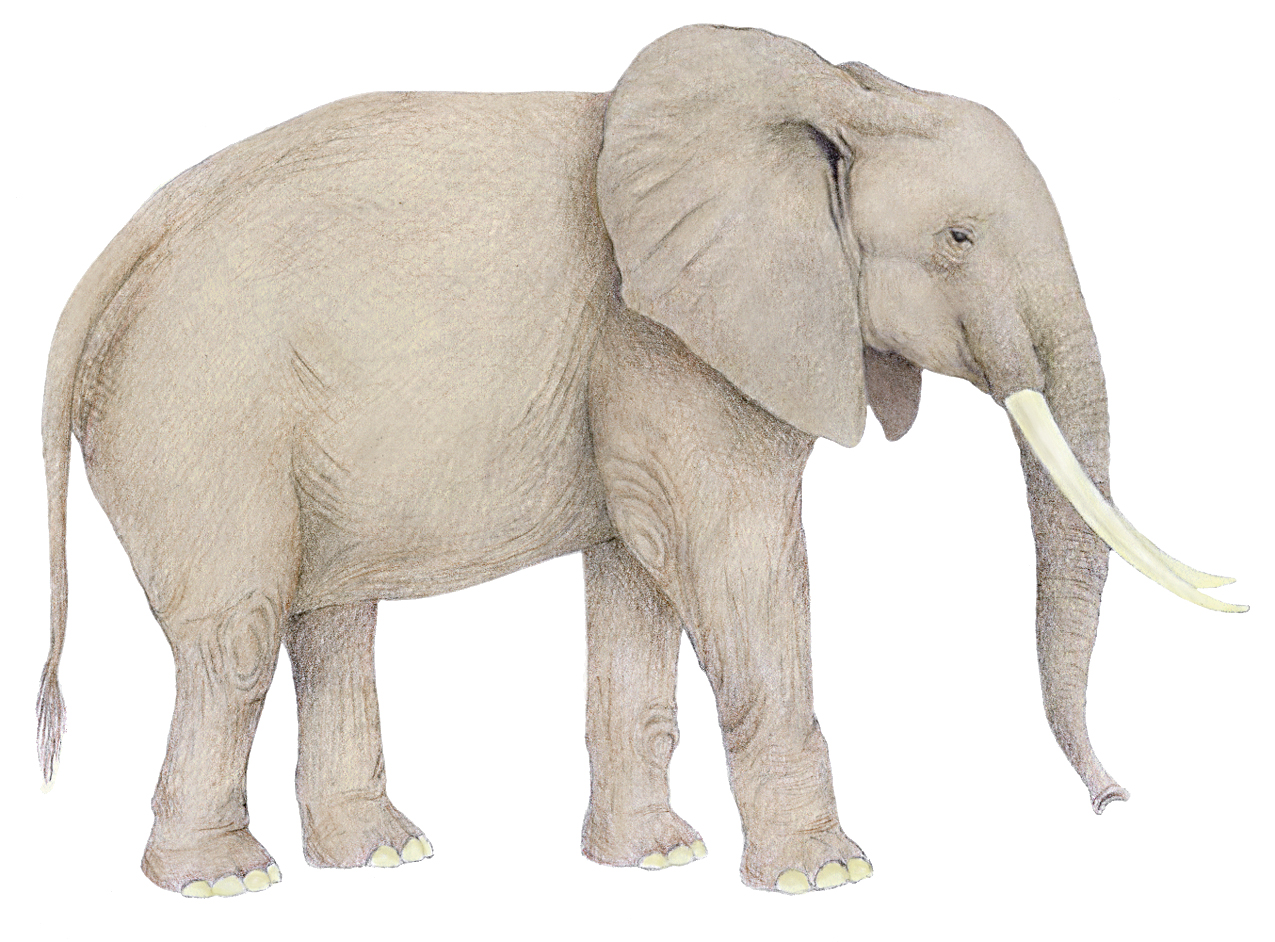
There are two species of African elephants—forest elephants and bush elephants, also known as savanna elephants. Bush elephants, which live in most countries south of the Sahara, are larger and have heavier tusks. Forest elephants live in Cameroon, Côte d’Ivoire, the Republic of the Congo, and other countries of central and western Africa. Both kinds of African elephants inhabit forests, grasslands, mountains, swamps, and shrubby areas.
Asian elephants
live only in southern and southeastern Asia. They are found in forests and jungles of Cambodia, China, India, Indonesia, Malaysia, Myanmar, Sri Lanka, Thailand, and Vietnam.

Asian elephants have an arched back that is slightly higher than the shoulder and the rump. An adult Asian bull stands from 9 to 101/2 feet (2.7 to 3.2 meters) tall at the shoulder and weighs up to 8,000 pounds (3,600 kilograms). The largest known Asian bull measured 10 feet 8 inches (3.3 meters) tall. Asian cows stand about 8 feet (2.4 meters) tall and weigh about 6,600 pounds (3,000 kilograms).
Most Asian elephants have light gray skin and may have pink or white spots. An Asian elephant has two humps on its forehead just above the ears. The ears are about half as large as those of an African elephant and do not cover the shoulder. Most Asian bulls have tusks that grow from 4 to 5 feet (1.2 to 1.5 meters) long. However, some Asian males, called makhnas, have no tusks, and many Asian females have none. Other Asian females have extremely short tusks called tushes.
The trunk of an Asian elephant has smoother skin than that of an African elephant and only one fingerlike structure on the tip. Most Asian elephants have five toes on each forefoot and four on each hind foot.
The body of an elephant
The height of an adult elephant about equals the length of the back of the elephant from head to tail. Scientists may or may not include the length of the trunk as well when giving the total length. An elephant has a short, muscular neck and an enormous head with huge, triangular ears. The trunk extends from the upper jaw, and a tusk may grow from each side of the jaw at the base of the trunk. Massive legs support the body. An elephant’s tail is small in relation to the rest of the animal. It measures about 31/2 feet (1.1 meters) long.
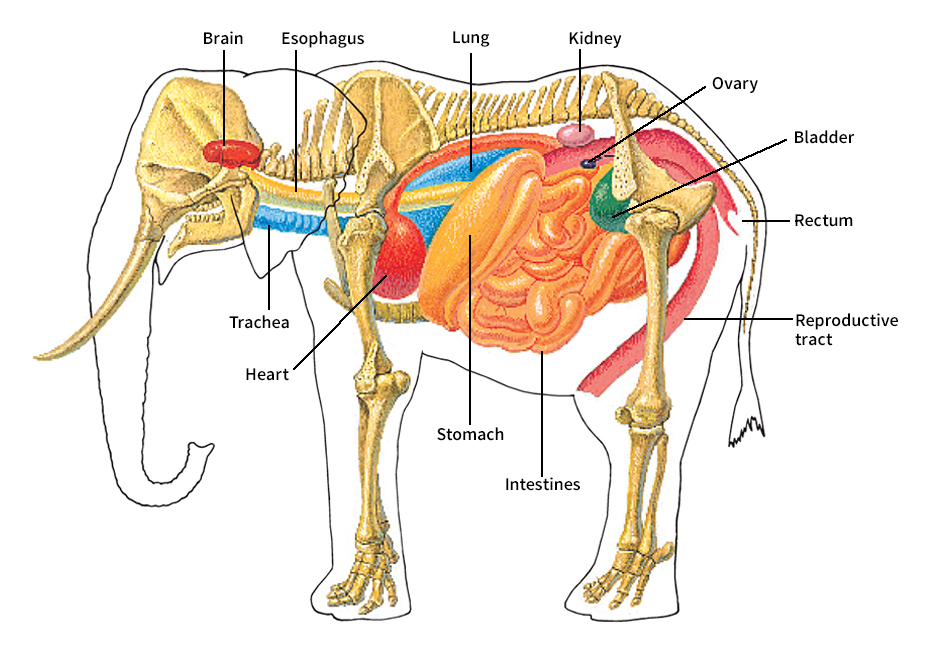
Skin and hair.
Elephants have gray, wrinkled skin. The skin of an adult measures up to 11/2 inches (3.8 centimeters) thick. It weighs about 2,000 pounds (900 kilograms). Elephants are called pachyderms, a term that comes from a Greek word meaning thick-skinned. However, an elephant’s skin is surprisingly tender. Some insects, including flies and mosquitoes, can bite into the skin.
An elephant has no sweat glands, and so it must cool off in other ways. It may get rid of excess body heat by flapping its enormous ears or by spraying water on itself. Elephants also stay cool by rolling in mud. The mud dries on the skin and thus shields it from the sun.
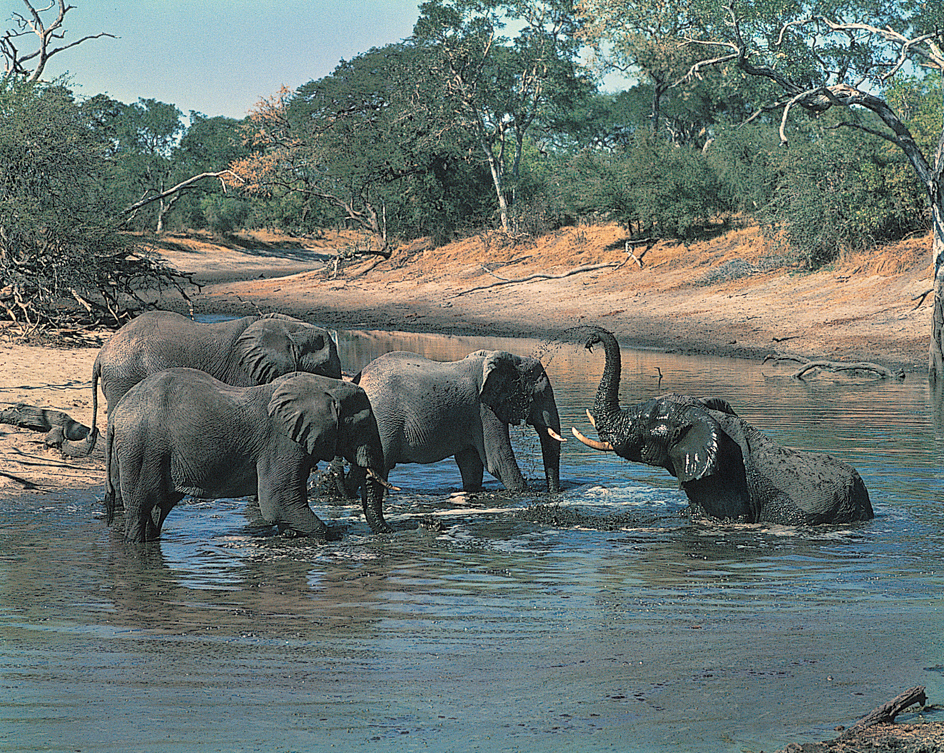
At birth, elephants are often covered with sparse brown, black, or reddish-brown hair that gradually wears off as they get older. Adult elephants appear to be nearly hairless. But there are bristles around the ears, eyes, and mouth, and sparse hair on the trunk, legs, and other parts of the body. The end of the tail has a long bunch of thick hairs.
Trunk.
An elephant’s trunk is a combined nose and upper lip. It consists of a strong, flexible, boneless mass of flesh. The trunk of an adult elephant measures about 5 feet (1.5 meters) long and weighs about 300 pounds (140 kilograms).
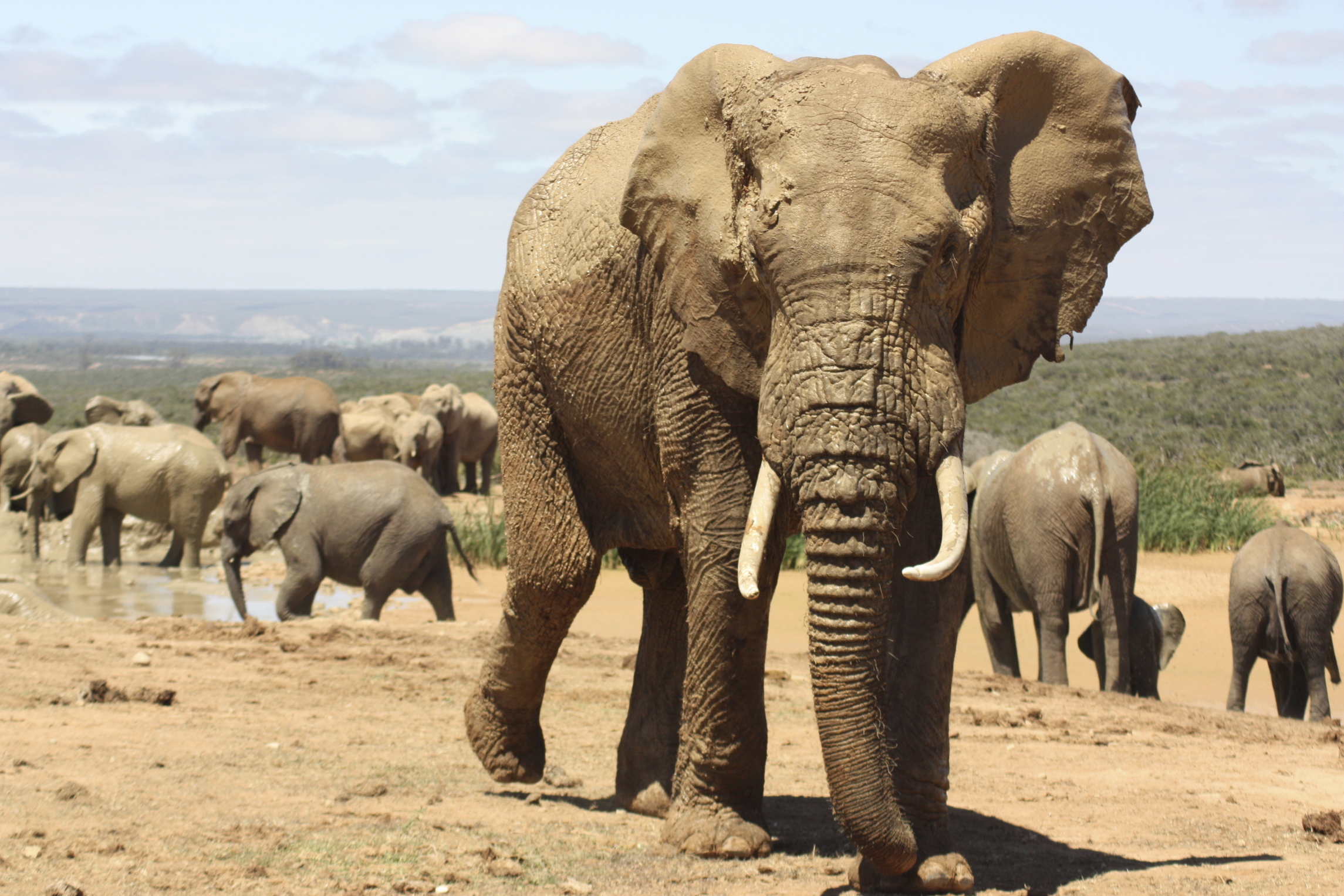
An elephant breathes and smells with its trunk and uses it when eating and drinking. The animal sniffs the air and the ground almost constantly with its trunk. It carries food and water to its mouth with its trunk. It also gives itself a shower by sucking water into the trunk and then spraying it out again. The trunk of an adult can hold about 11/2 gallons (6 liters) of water.
An elephant grasps objects with its trunk much as a person does with a hand. The trunk can carry a log that weighs as much as 600 pounds (272 kilograms). The tip of the trunk can pick up an object as small as a coin. An elephant also uses its trunk to communicate with other elephants. When two elephants greet each other, they touch trunks. A mother will comfort her calf by stroking it with her trunk. Young males play-fight by wrestling with their trunks. In a true fight, the trunk is usually protected by curling it under the chin.
Tusks and teeth.
An elephant’s tusks are actually long, curved upper teeth called incisors. They are made of ivory. About two-thirds of each tusk extends from the upper jaw. The rest is in the skull. Elephants use their tusks to dig for food and water and to fight. The tusks can lift and carry a load weighing as much as 2,000 pounds (900 kilograms). Some African elephants carry tusks weighing more than 100 pounds (45 kilograms) each. These elephants are known as “big tuskers” or “hundred pounders.” Many Asian females and some Asian males have no tusks.
Elephants also have four molars (back teeth). The molars of an adult may measure 1 foot (30 centimeters) long and weigh about 81/2 pounds (4 kilograms). These teeth have jagged edges that help grind food. One molar lies on each side of both jaws, and additional molars form in the back of the mouth. The molars in front gradually wear down and drop out, and the ones in back push forward and replace them. An elephant grows six sets of molars during its lifetime. Each set consists of four teeth. The last set of molars appears when the animal is about 40 years old.
Legs and feet.
The legs of an elephant are pillarlike structures. The feet are nearly round. Each foot has a thick pad of tissue that acts as a cushion. The foot expands under the elephant’s weight and contracts when the animal lifts the leg. Elephants may sink deep into mud, but they can pull their legs out easily because the feet become smaller when lifted.
Senses.
The trunk provides a keen sense of smell, and elephants depend on this sense more than on any other. They frequently wave their trunks high in the air to catch the scent of food or enemies. An elephant can smell a human being more than a mile (1.6 kilometers) away.
Elephants also have good hearing. They can make and hear sounds below the range of human hearing. These low sounds, called infrasound, travel farther than higher sounds. Elephants can communicate with each other at a distance of at least 21/2 miles (4 kilometers), and possibly twice that distance.
The elephant’s sense of touch is most keen in its trunk, especially at the tip. An elephant can recognize the shape of an object and whether the object is rough or smooth and hot or cold.
Elephants have poor sight. Their eyes are small in relation to the enormous head. An elephant cannot turn its head completely, and so it can see only in the front and to the sides. The animal must turn around to see anything behind it.
Intelligence.
Elephants have a large brain and rank high in intelligence among animals. In the wild, their social lives are complex and involve learning many behaviors and communication skills. Studies of the African elephant have shown that these animals make at least 70 different calls, each with a specific meaning. Elephants have excellent memories, which they use both in their social activities and in their travels over large areas. The matriarch (oldest adult female) is the carrier of knowledge for the whole family. She knows the migration routes, where to find trees with fruit, how to find water during droughts, and other information for survival. This knowledge is passed on to the younger females in her family and eventually one of them will become the matriarch.
The life of an elephant
Elephant families.
Adult males and females live separately most of the time. The cows and their babies, called calves, live in family units averaging 10 to 20 members each. Families consist of three or four related adult females and their offspring, which range from newborn calves to calves up to 13 to 14 years old. Each family is led by the oldest female, the matriarch. Males leave the family as they reach maturity. Males then form bonds with other males and only visit the family groups occasionally.
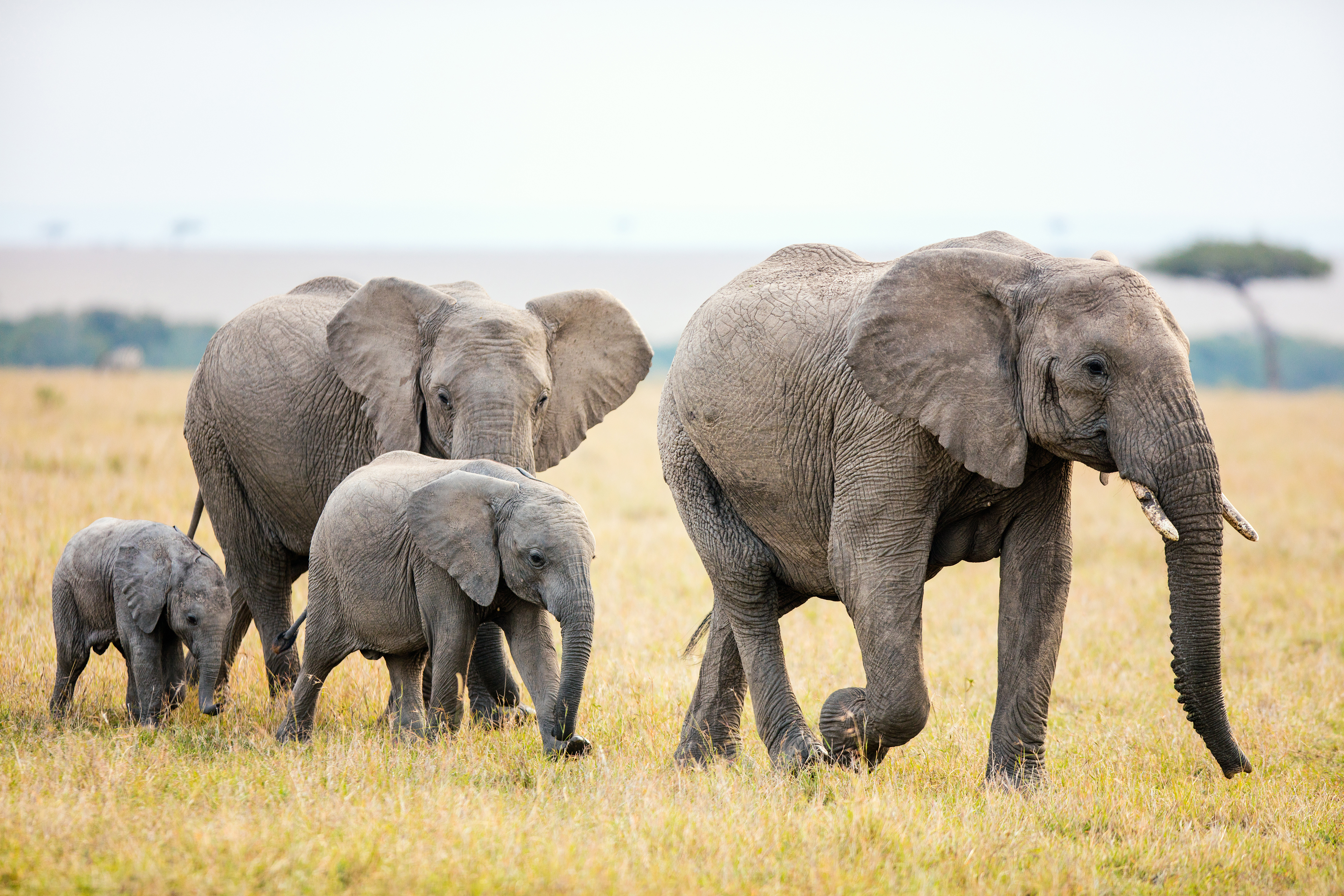
A population of elephants is made up of all the family groups and independent adult males that share one area. Populations vary in size from a few hundred elephants to several thousand. Each population ranges over a particular area in search of food. In semidesert areas, elephants may have to travel over vast distances to find food. In areas with high rainfall and abundant vegetation, a population may limit itself to as little as 100 square miles (250 square kilometers).
Wild elephants usually eat for about 16 hours every day. They bathe in lakes and rivers and like to roll in muddy water. After a mud bath, an elephant may cover itself with dirt. The dirt coating helps protect the animal’s skin from the sun and insects. Elephants often play by tussling among themselves with their tusks and trunks.
Loading the player...African elephants bathing
Elephants communicate with one another in various ways, including postures, gestures, odors, and, especially, sounds. Elephants make many kinds of rumbling sounds, and each has a different meaning. For example, an elephant calf makes a hoarse, loud rumble when it is frightened, and a mother elephant uses a low, humming rumble to calm her calf. Other sounds made by elephants to communicate include screams, roars, bellows, groans, and squeaks.
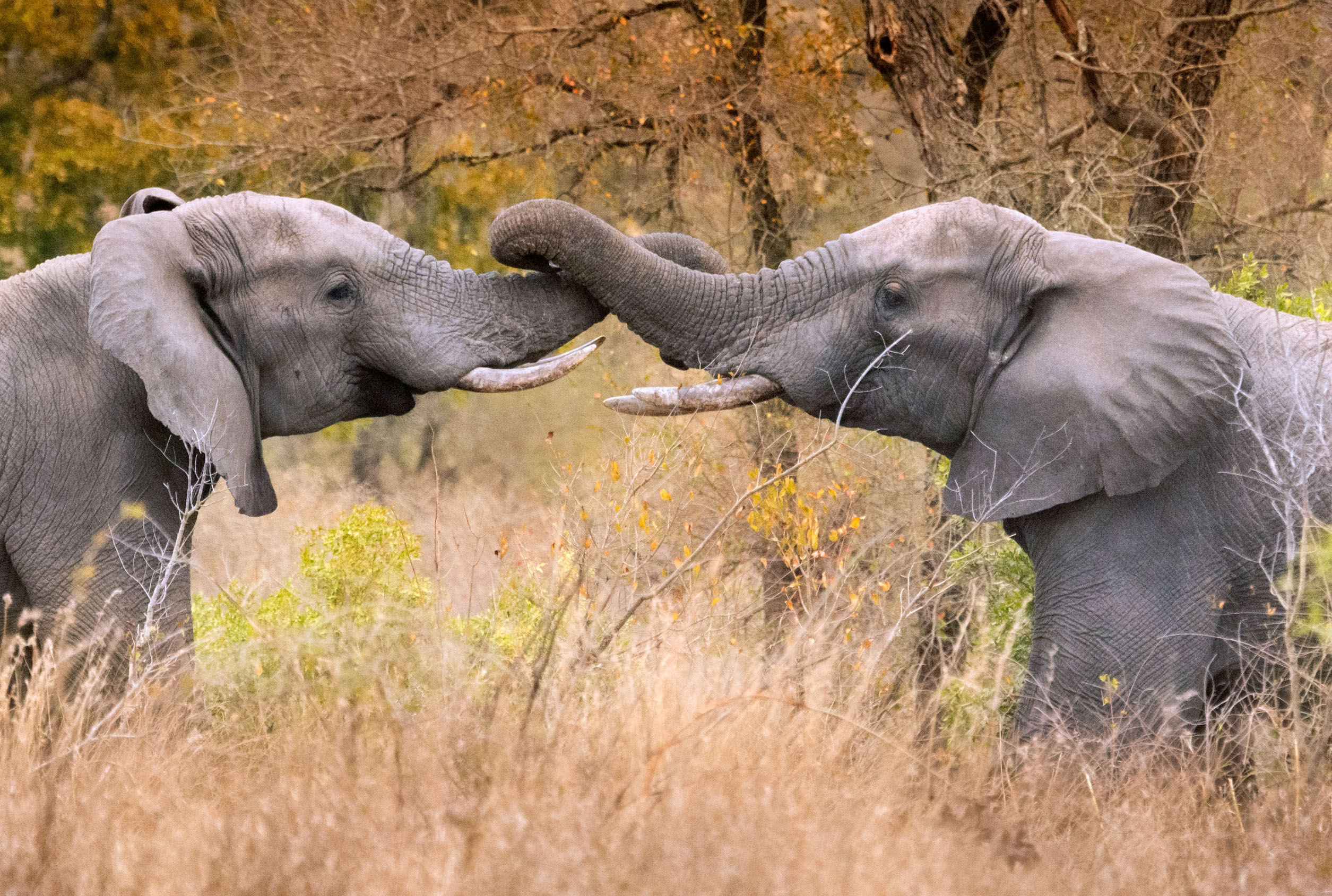
Food.
Elephants eat grass, water plants, and the leaves, roots, bark, branches, and fruit of trees and shrubs. Using their heads as battering rams, they sometimes knock down small trees to reach the highest leaves. An elephant can knock down a tree that measures 30 feet (9 meters) in height and has a diameter of almost 2 feet (61 centimeters).
Loading the player...Elephants eating in a marsh
Elephants use their tusks to rip the bark off trees. They also dig up roots and shrubs with their tusks. Elephants especially like bamboo, berries, coconuts, corn, dates, plums, and sugar cane. Elephants do not eat the flesh of other animals.
A large adult wild elephant eats about 300 pounds (140 kilograms) of vegetation a day. Wild elephants drink up to 40 gallons (150 liters) of water daily. An elephant can live without water for about three days and may travel as far as 50 miles (80 kilometers) to find it.
Travel.
The padded feet of an elephant enable the animal to walk and run with surprisingly little noise. Elephants normally walk at a speed of 3 to 6 miles (5 to 10 kilometers) an hour. When making a long journey, a family walks at about 10 miles (16 kilometers) an hour. An angry or frightened elephant can run faster than 35 miles (56 kilometers) an hour, but only for a short distance. An elephant walks and runs with shuffling steps. It cannot jump because of its weight and the structure of its legs.
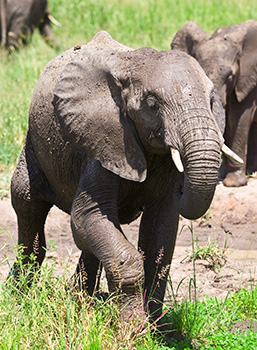
Elephants usually roll in mud or swim at least once a day. They are excellent swimmers and have been known to swim to islands in lakes or off seacoasts. They hold their trunks above water when swimming.
Reproduction.
Male elephants reach adulthood when they are 10 to 14 years old. But most do not mate until they are over 30 years old. The main reason for this delay is that older males prevent younger males from mating. In addition, females do not usually accept teenaged males as mates. Females stay in their family and begin mating at an average age of 12. They may have their first calf at age 13 or 14 and usually produce one calf every four to five years until well into their 50’s.
The female carries her young for 22 months. She almost always has one calf at a time, but twins occasionally are born. African elephant calves weigh from 255 to 320 pounds (116 to 145 kilograms) at birth and stand about 3 feet (90 centimeters) tall at the shoulder. Newborn Asian elephant calves weigh about 220 pounds (100 kilograms) and are about 24/5 feet (85 centimeters) tall.
A baby elephant can walk less than an hour after birth. Its mother stays close to the youngster and protects it for several years. At first, the calf lives chiefly on the mother’s milk. The young elephant drinks the milk by curling its trunk over its head so its mouth can reach the mother’s breast. When the calf is 3 to 4 months old, it starts to graze on grass and other plant life. Male calves stay with the mother until they are about 14 years of age. Female offspring remain with the mother until she dies. Elephants grow throughout their lifetime. As a result, the older an elephant is, the bigger it is. Males grow more than females, and a large adult male in his 40’s is almost twice the size of a female that age.
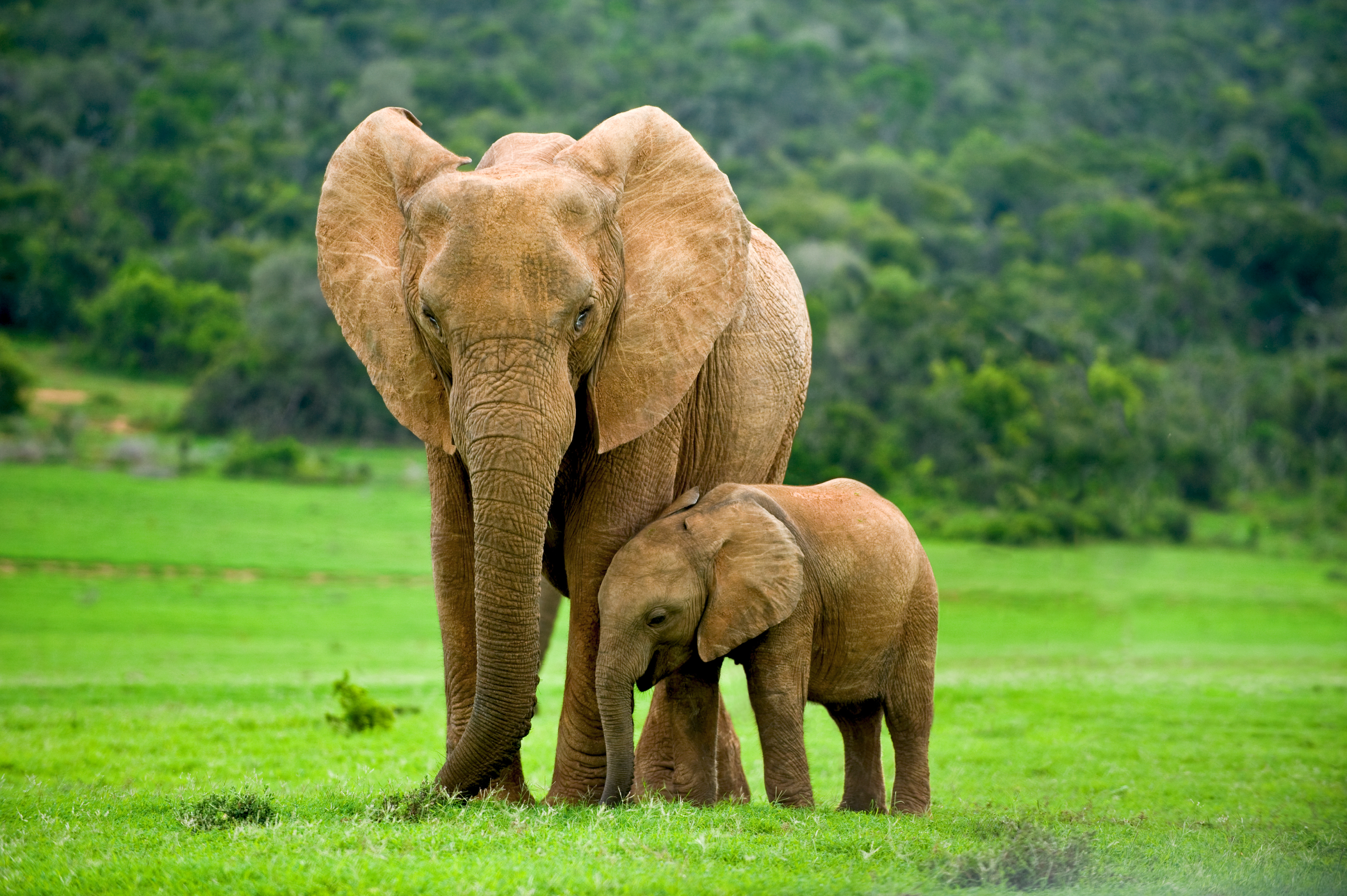
Musth.
An elephant has a temporal gland on each side of its head, about midway between the eye and the ear. About once a year, the temporal glands of large adult males swell and discharge a dark, oily substance that has a strong odor. This substance stains the elephant’s face. The temporal glands are active for two or three months yearly. During this period, an elephant is in a condition called musth or must (both pronounced muhst). In the wild, musth usually occurs only in adult male elephants over 25 years old.
While in musth, a captive elephant can become dangerous. It may attack nearby animals, including people and other elephants. Elephants in captivity must be chained or caged during musth.
For many years, zoologists did not understand the purpose of musth. But studies of wild African elephants revealed that musth occurs periodically, at a time when the elephant’s body produces more than the normal amount of a hormone called testosterone. Musth gives a particular male dominance over other males that are not in musth at that time. Although elephants can mate when not in musth, the musth male is more aggressive and thus able to fight for and guard a female. A female elephant shows a preference to mate with a male in musth. Females are ready to mate during a period of sexual arousal called estrus, which lasts about four days at a time.
Loading the player...African elephants fighting
Protection against enemies.
The great size of elephants protects them from almost all other animals. Lions in Africa and tigers in Asia can kill elephant calves, but such instances are rare. When under attack, the elephant family forms a circle around the calves to protect them. An elephant may scare an enemy away by sticking its ears straight out and charging. If an animal attacks, an elephant may crush it to death by kneeling on it.
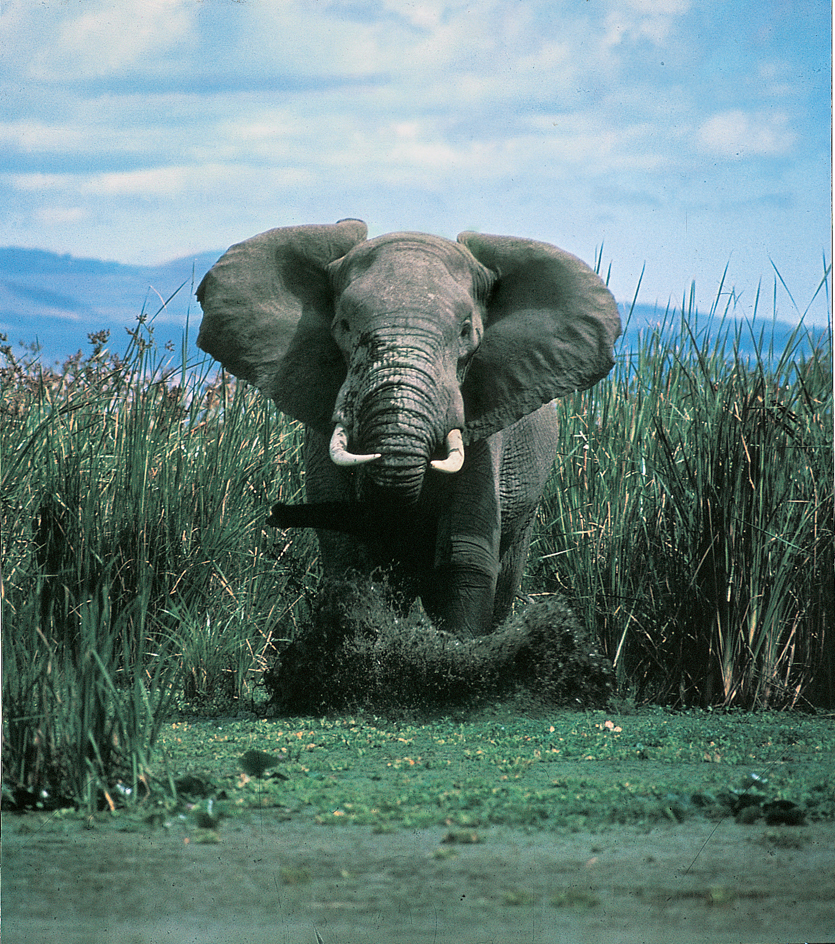
The greatest enemies of elephants are people. Until modern times, elephants could often protect themselves from hunters by a group defense. Now whole families of elephants can be gunned down by hunters with automatic weapons.
Elephants are easily frightened in areas where they are hunted. A sudden noise, such as a gunshot, can cause a herd to panic. The animals may charge at the source of the noise or stampede away from it. When frightened or excited, elephants sometimes use their trunks to make a loud, shrill cry called trumpeting.
Loading the player...Life span.
An elephant can live to about 65 years and sometimes into the 70’s. If it does not die from drought or disease or is not killed by hunters, the cause of death will usually be the wearing down of the sixth—and final—set of molars. Once the last set is worn down, the elephant dies of malnutrition.
Some people believe that old elephants go to certain places called “elephant graveyards” to die. This belief may have started because sick or aged elephants tend to go to a part of their range where there is shade and soft vegetation. In these places, people have found the bones of many elephants.
Protecting elephants
Elephants are the only survivors of a group of mammals called proboscideans. This group of animals once consisted of more than 350 species, all of which had long snouts or trunks. The earliest known proboscideans lived in Africa and Asia about 50 million years ago. Other proboscideans included the mammoth and the mastodon. Both animals looked much like the elephant.
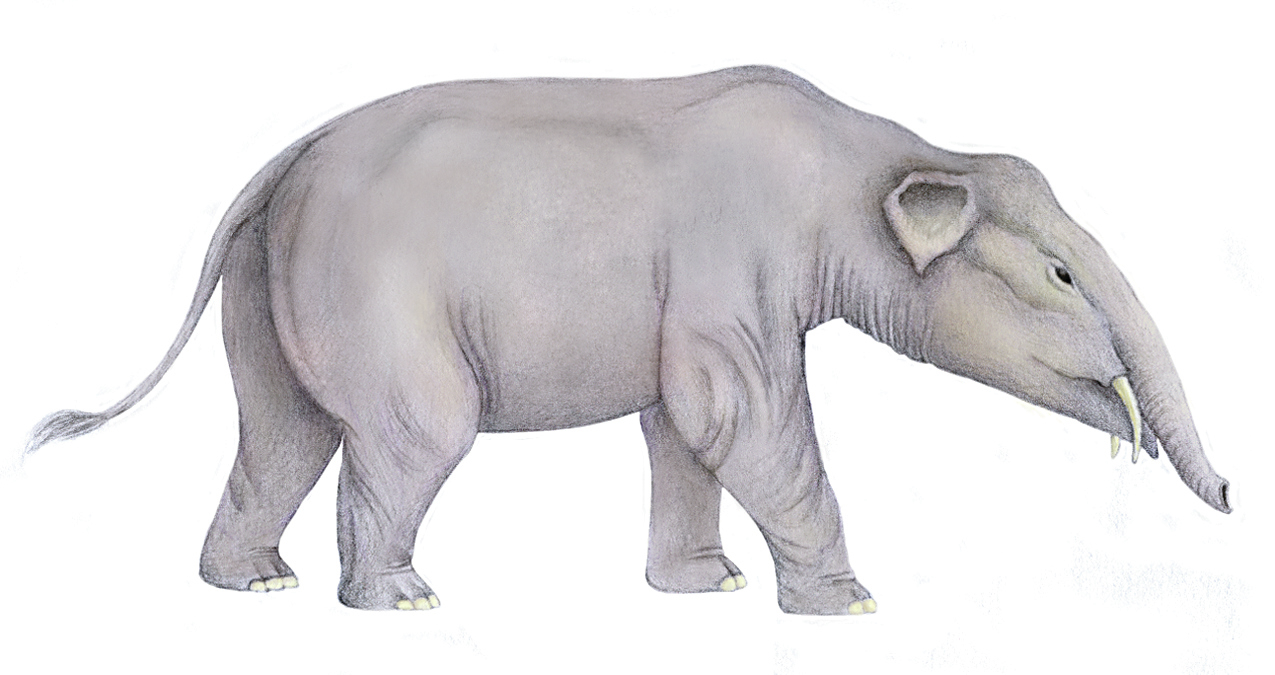
Today, wildlife experts agree that elephants are in great danger and need human protection to survive. People have destroyed much of the elephant’s natural surroundings by clearing land for settlement and farms.
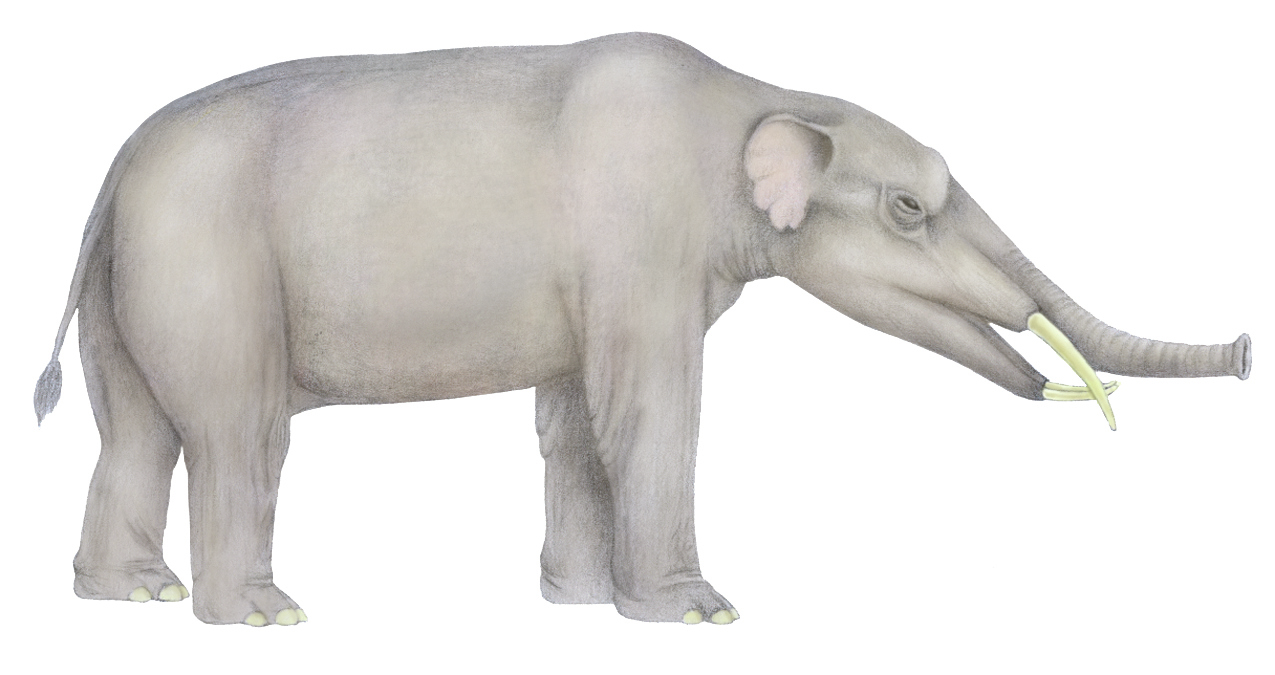
Many African and Asian nations have set aside land to protect the habitats of elephants and other wild animals. This land lies in national parks and in areas called reserves. But some wildlife experts fear that this amount of land is not large enough to save many wild elephants.

Illegal hunting for ivory also threatens the survival of wild elephants. Laws forbid elephant hunting in national parks and in reserves, and they limit the number that sport hunters may kill outside these areas. Sport hunting can usually be controlled, but poachers with automatic weapons can kill thousands of elephants yearly.
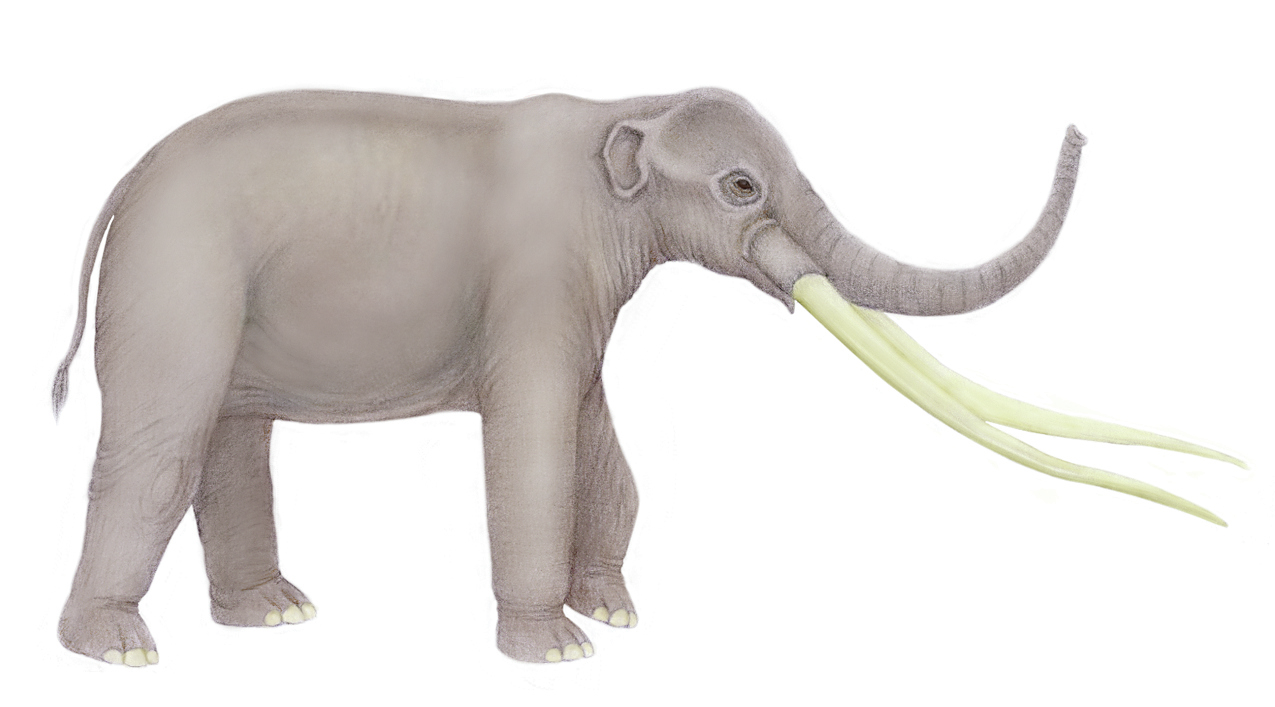
The number of African elephants greatly declined in the 1970’s and 1980’s. Conservation groups worldwide worked to halt the decline. As a result, all trade in ivory and other elephant products was banned by the Convention on International Trade in Endangered Species of Wild Fauna and Flora (CITES) in 1989. Beginning in 1997, however, CITES members have allowed such African countries as Botswana, Namibia, and South Africa to export certain elephant products and to sell, on a limited basis, small amounts of ivory to Japan and other countries. This legal trade has once again encouraged the illegal trade.

In the 2000’s and 2010’s, the poaching of elephants rose once again. More than 100,000 African elephants were killed during this time. In addition, conservationists estimate there may be fewer than 20 big tusker elephants left on Earth. Nearly half of these hundred pounders live in southern Kenya. Conservation groups, including the Tsavo Trust and the Amboseli Trust for Elephants, are working to secure a future for the big tuskers and for elephants worldwide.
